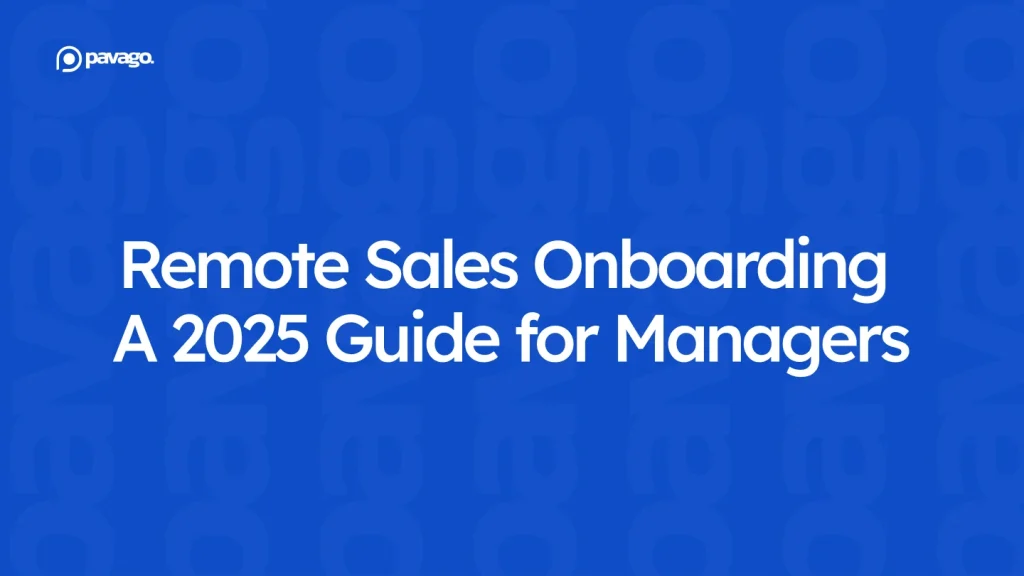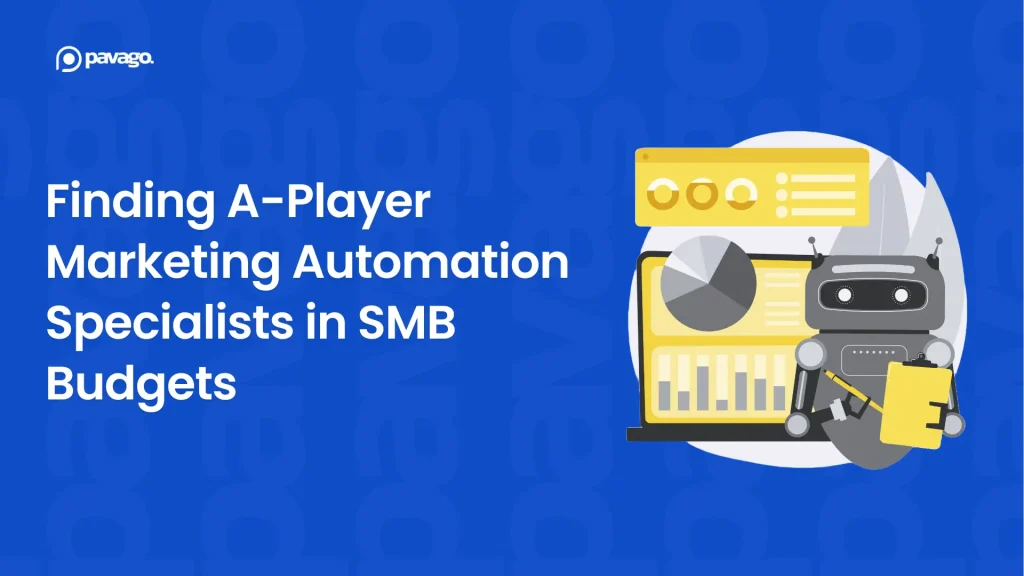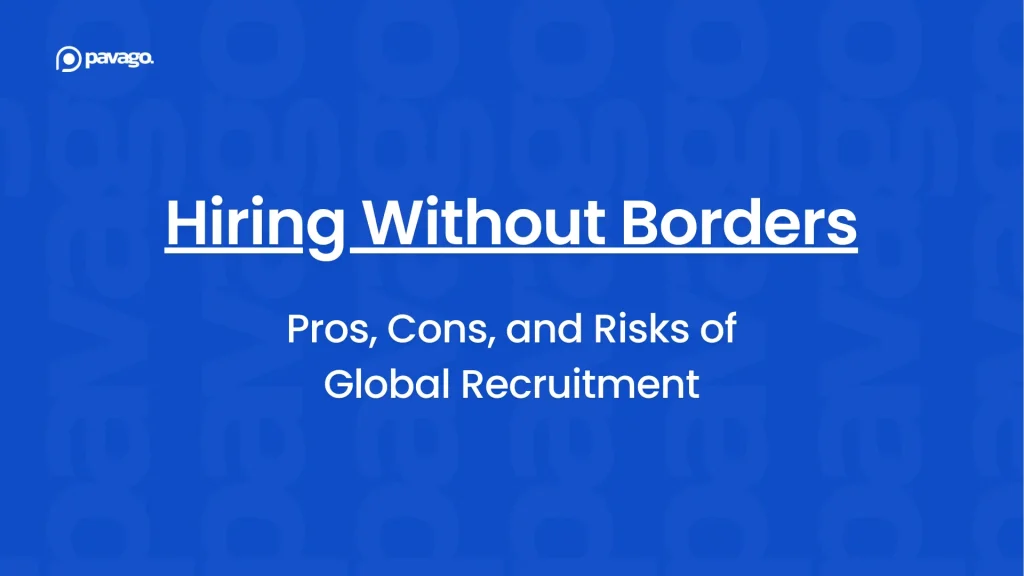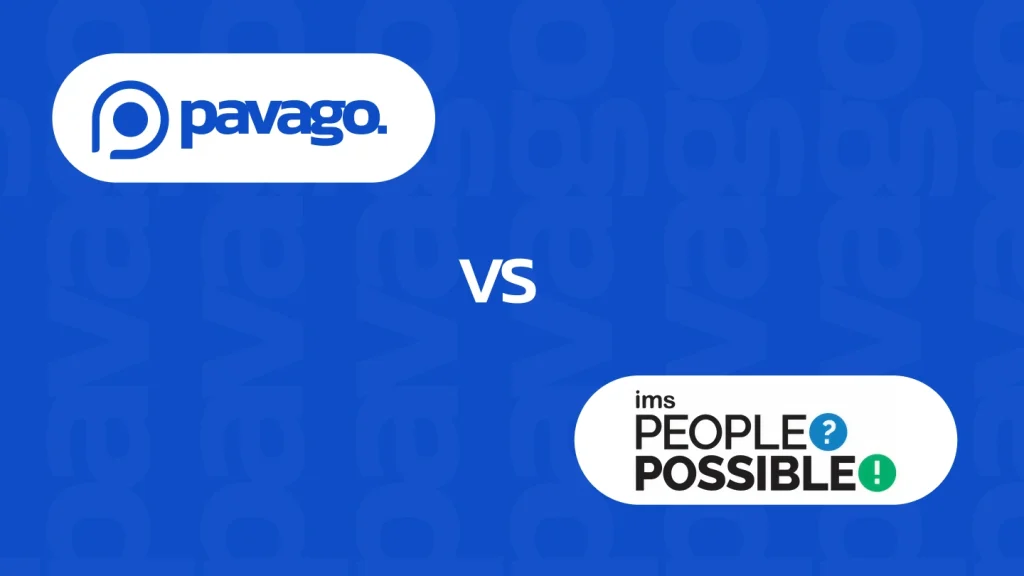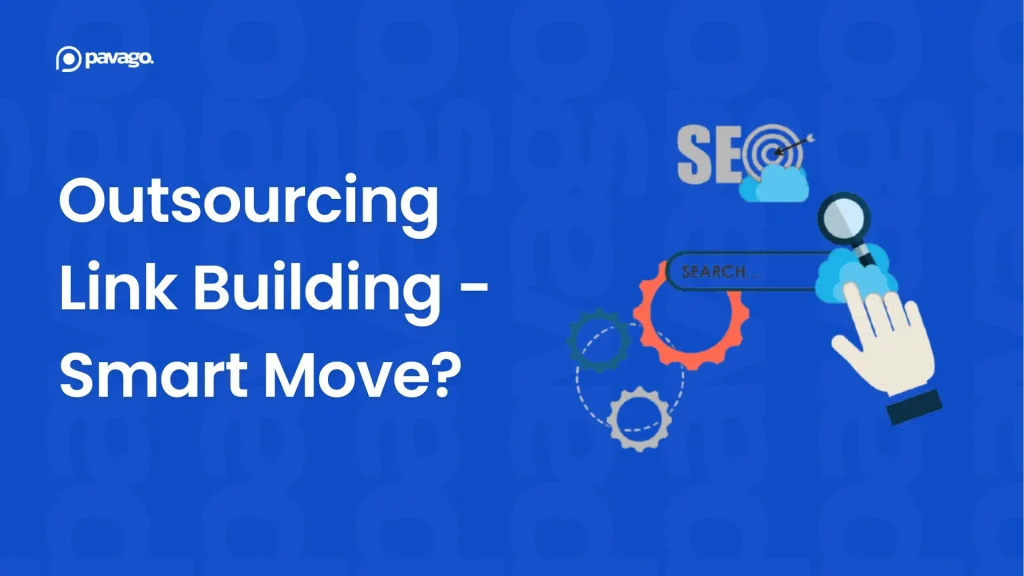Will the remote salesperson you just hired start closing deals on day one?
Well, it’s possible in some cases—but it shouldn’t be your expectation.
To help SDRs succeed, you must provide them with the right tools, introduce them to your sales culture, and guide them through your processes. Even the most talented hires can struggle to find their footing without the right direction.
This is where a strong sales onboarding process becomes essential.
We have put together this guide to help sales managers understand the sales onboarding process with actionable steps and best practices.
What is Sales Onboarding?

In sales, every day counts. Unlike other roles, salespeople don’t have the luxury of a long runway—they’re under pressure to deliver results fast. That’s why a solid onboarding process isn’t just a nice to have; it’s a critical investment in their success.
Sales onboarding is more than a corporate welcome party or a crash course in your product. It’s about equipping new employees with everything they need to excel—from understanding your sales approach and mastering the tools of the trade to internalizing your company’s unique selling standards.
Think of onboarding as your chance to lay a strong foundation. It’s not just about introducing them to the team or walking through a sales deck—but helping them understand what “winning” looks like in your organization. This process should start when your sales development representatives log in for the first time and evolve over the coming weeks and months.
The ROI of effective onboarding is undeniable. It shortens ramp time, maximizes the investment you made in hiring, and drives productivity in a role where time really is money. Yet, many companies still neglect to implement a structured onboarding plan, leaving reps to figure it out on their own.
Structure and transparency are even more important when your onboarding is fully remote.
If you want your new sales hires to hit the ground running and perform at their best, it’s time to rethink how you hire and onboard your remote sales team.
Why Is Remote Sales Onboarding Unique?

The remote sales environment brings distinct challenges:
- Geographic dispersion: Business development representatives lack the physical presence of a team, which can lead to feelings of isolation.
- Dependence on digital tools: Mastery of tools like CRMs and prospecting platforms is critical.
- Consistency across teams: Managers must ensure uniform onboarding experiences regardless of location.
SDRs stick around for an average of 14-18 months, and ramp-up takes 3.5 months according to Hubspot. That’s almost a quarter of their time just getting up to speed.
If you don’t onboard them effectively right from day one, you risk wasting time, losing top talent, and starting the hiring cycle all over again. But when you nail outsourced sales team onboarding, you speed up their productivity and get them ready to roll up their sleeves to excel.
Set Clear Expectations While Onboarding Remote Salespeople

To build a high-performing remote SDR team, you need to address critical expectations during sales onboarding. Here’s how to set the tone and ensure accountability:
Emphasize Dependability
Make it clear that reliability is non-negotiable. Candidates should commit to consistent attendance, avoid excessive leave, and stay focused on the grind—handling a high volume of calls daily.
Prioritize Reliability in Call Management
Stress the importance of staying engaged during work hours. Your remote sales staff should take calls responsibly and minimize unnecessary time away from their core tasks.
Assess and Improve Communication Skills
Effective communication is key. Ensure the candidate’s speech is clear and stutter-free, so they can deliver a confident and professional experience for prospects.
Train for Objection Handling
Teach your inbound sales reps to handle objections with poise. Confidence in responding to tough questions or hesitations can make or break a deal.
Build Confidence Early
Confidence is contagious. Evaluate and coach SDRs to sound self-assured on calls, making prospects trust and engage with them.
💡 Pro Tip: During remote onboarding, outline these expectations explicitly. Set measurable benchmarks to hold SDRs accountable for their performance. Clear guidelines now will prevent misunderstandings and future discrepancies.
The Four-Stage Framework for Remote Sales Onboarding
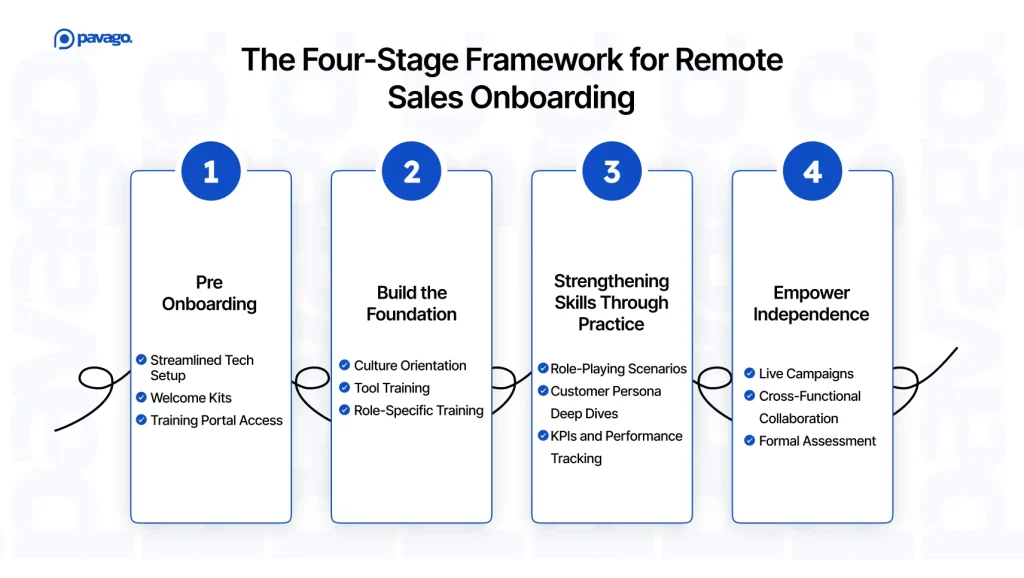
1. Pre-Onboarding
The journey starts before day one. First impressions count, and pre-onboarding sets the tone for the entire process.
Key Actions
- Streamlined Tech Setup: Ship laptops, and headsets, and ensure seamless access to sales tools (CRMs, communication platforms, etc.). Share step-by-step guides to avoid technical hiccups.
- Welcome Kits: Send a branded kit with company swag, a personalized note, and role-specific resources.
- Training Portal Access: Provide access to a centralized repository with FAQs, video tutorials, and key resources, like sales playbooks and prospecting guides.
💡 Pro Tip: Introduce an onboarding buddy to provide informal support during the first few weeks. This personal touch goes a long way in reducing anxiety.
2. The First 30 Days: Build the Foundation
The first month is all about introducing new sales hires to your company’s values, culture, and sales process. Aim for a structured yet engaging approach.
Key Actions:
- Culture Orientation: Kick off with an interactive session where you share your company’s story, mission, and vision. Use engaging formats like live Q&As or virtual meet-and-greets.
- Tool Training: Provide hands-on sessions for CRMs (e.g., Salesforce, LeadSquared) and prospecting tools like LinkedIn Sales Navigator. Include quizzes to test understanding.
- Role-Specific Training: Equip SDRs vs BDRs with scripts, objection-handling techniques, and call frameworks. Use recordings of successful sales calls for real-world examples.
💡 Pavago Insight: Create role-specific microlearning modules, such as prospecting best practices or email personalization strategies, to keep the training engaging and effective.
3. The Next 30 Days: Strengthening Skills Through Practice
After the foundation is set, the focus shifts to skill-building through role-playing, shadowing, and live practice.
Key Actions:
- Role-Playing Scenarios: Conduct weekly sessions where new hires practice cold calls and handle objections. Incorporate manager feedback for improvement.
- Customer Persona Deep Dives: Train reps on Ideal Customer Profiles (ICPs) and common pain points to sharpen their outreach.
- KPIs and Performance Tracking: Introduce measurable goals (e.g., calls made, emails sent, demos booked) and track progress through a CRM dashboard.
💡 Pro Tip: Use tools like Slack or Microsoft Teams to create a “learning channel” where reps can ask questions and share tips in real time.
4. Day 90 and Beyond: Empower Independence
The final stage is about transitioning reps into full autonomy. By this point, they should have the confidence and skills to contribute effectively to your sales pipeline.
Key Actions:
- Live Campaigns: Assign reps their first set of leads and provide regular feedback through call reviews.
- Cross-Functional Collaboration: Introduce new hires to marketing, product, and customer success teams to understand how their work impacts the broader organization.
- Formal Assessment: Conduct a 90-day review that evaluates skill mastery, KPI achievement, and cultural alignment.
💡 Pavago Insight: Create a personalized growth plan for each rep after the 90-day review, focusing on areas like advanced selling techniques or leadership development.
Best Practices for Elevating Your Sales Onboarding

1. Build a Centralized Knowledge Hub
Use platforms like Circle or Notion to store training materials, product knowledge, and call scripts.
Keep content updated to reflect changes in tools, processes, or ICPs.
2. Encourage Peer-to-Peer Learning
Schedule bi-weekly team calls where reps share successful strategies.
Incorporate collaborative tools like Miro for brainstorming and feedback.
3. Prioritize Communication and Culture
Foster inclusivity through virtual happy hours or informal coffee chats.
Recognize milestones such as the first closed deal to build morale.
💡 Pro Tip: Use gamification to make training fun. For example, create a leaderboard for completed modules or most leads booked.
Common Mistakes to Avoid

- Information Overload: Avoid bombarding reps with everything at once. Break content into manageable chunks over the first 90 days.
- Neglecting Follow-Ups: Onboarding doesn’t end after three months. Regular check-ins ensure continuous development.
- Failing to Tailor Training: One-size-fits-all onboarding is ineffective. Customize training to individual roles and skill levels.
How to Measure The Success of Sales Onboarding?
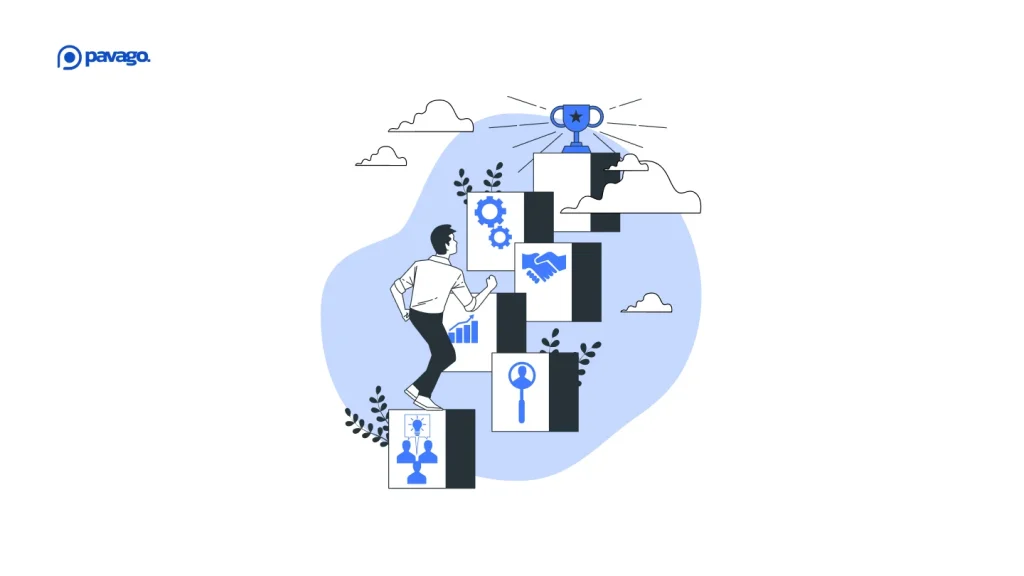
Metrics to Monitor
- Ramp Time: How quickly reps achieve full productivity.
- Engagement Levels: Participation in training and role-playing sessions.
- Sales Metrics: Number of leads contacted, deals closed, and revenue contribution within the first 90 days.
💡 Pavago Insight: Use dashboards like Bloom Growth to provide real-time visibility into onboarding KPIs and identify areas for improvement.
Sales Onboarding Tools & Software
Equip your SDRs with these essential platforms to streamline their workflow, boost productivity, and track their performance.
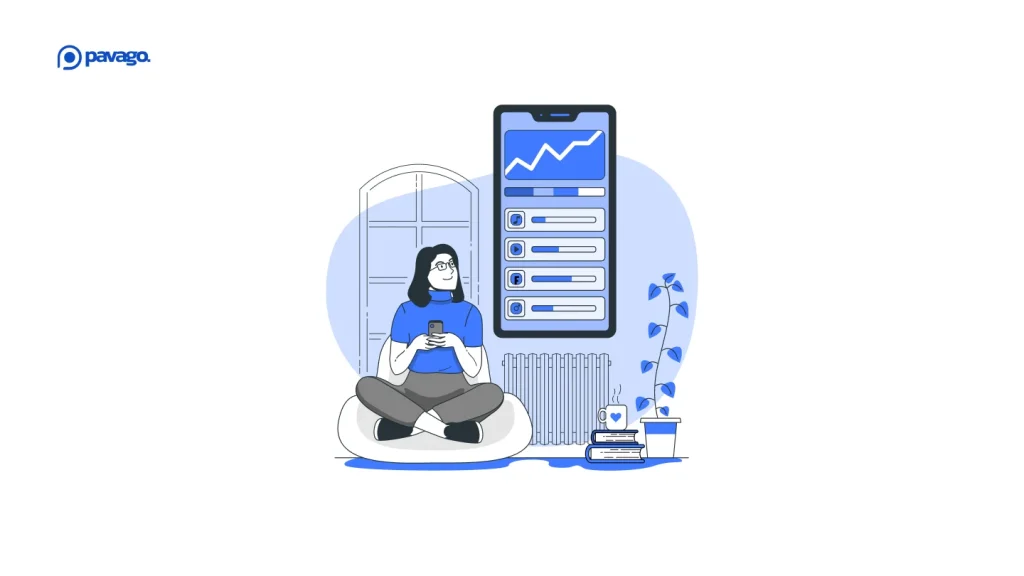
1. CRM Integration for Email Tracking
Connect your email platform to your CRM. This will allow you to track clicks, opened emails, and engagement metrics seamlessly. Knowing how prospects interact with outreach gives SDRs valuable insights for follow-ups.
2. Kixie for Cold Calling
Kixie is a powerful dialing software designed for sales teams. It simplifies cold calling, automates workflows, and helps SDRs manage high call volumes efficiently.
3. Google Calendar for Scheduling
A well-organized calendar is essential for remote teams. Google Calendar helps SDRs stay on top of their calls, meetings, and follow-ups, ensuring they never miss a beat.
4. Google Drive for Document Sharing
Use Google Drive to centralize onboarding resources, sales playbooks, and training materials. With real-time collaboration, new hires can easily access everything they need.
5. Otter.ai for Meeting Summaries
Otter.ai is a game-changer for remote sales teams. It provides AI-powered meeting transcription and summaries, allowing SDRs to focus on the conversation instead of note-taking.
6. FoxClocks for Time Zone Management
With remote teams often working across multiple time zones, FoxClocks keeps everyone aligned. This browser extension displays various time zones directly on your browser, so SDRs can schedule calls confidently.
Final Thoughts
Sales onboarding isn’t just a one-time task—it’s an ongoing investment in your team’s success. It requires intentional effort, adaptability, and the right mix of tools and processes to align new reps with your company’s goals.
The effectiveness of your onboarding program depends on your ability to combine clear expectations, practical training, and a supportive culture that prioritizes growth.
A great sales onboarding experience does more than teach systems or processes—it sets the stage for long-term success. It shows new hires that you’re as invested in their development as you are in achieving company objectives. When SDRs and BDRs feel equipped, valued, and empowered, they’re more likely to embrace the team’s vision, perform confidently, and stay motivated.
Your sales onboarding process is the foundation for building not just capable sales reps but future sales leaders. It’s also a powerful tool for attracting top talent—creating a reputation for excellence that draws the best in the market.
Hire and Onboard Remote Sales Team with Pavago
Building a remote sales team can feel overwhelming, but with Pavago, the process becomes seamless and efficient. We specialize in helping businesses like yours hire top-tier remote SDRs and BDRs globally, ensuring you don’t just fill roles but bring in talent that fits your unique needs and culture.
Here’s why Pavago is the go-to solution for hiring and onboarding remote sales teams:
1. Access to the Top 1% Sales Talent
Our rigorous vetting process ensures you hire only the best sales professionals. Whether you need skilled SDRs for prospecting or business development reps to manage your sales pipeline, we connect you with sales candidates who deliver results.
2. Customized Onboarding Support
Pavago doesn’t stop at hiring. We assist in onboarding your new team members by offering role-specific training recommendations, tool setup, and structured onboarding frameworks. This ensures your sales reps are equipped to hit the ground running.
3. Cost-Effective Solutions
Offshore hiring through Pavago allows you to save up to 70% on employment costs while maintaining high-quality standards. We are currently hiring from Malaysia, Africa, Pakistan, and Latin America ensuring you gain top-notch talent without breaking the bank.
4. Proven Track Record
From digital marketing agencies to SaaS startups, businesses across industries trust Pavago to build and scale their remote teams. Our tailored approach ensures you get sales reps who align with your goals and contribute to long-term success.
5. Comprehensive Support System
We go beyond traditional recruitment. Pavago provides ongoing support, including access to resources, training recommendations, and expert guidance to ensure your remote sales team thrives.
When you partner with Pavago, you’re not just hiring remote sales reps—you’re building a team that’s driven, skilled, and ready to exceed expectations. Let us help you find the talent you need to scale your business.
Ready to Scale Your Business? Hire and Onboard Remote Sales Reps with Pavago.
